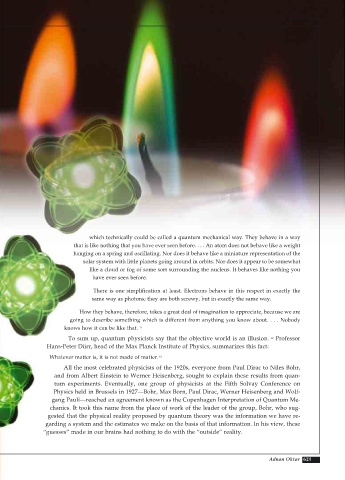Page 623 - Atlas of Creation Volume 4
P. 623
Harun Yahya
which technically could be called a quantum mechanical way. They behave in a way
that is like nothing that you have ever seen before. . . . An atom does not behave like a weight
hanging on a spring and oscillating. Nor does it behave like a miniature representation of the
solar system with little planets going around in orbits. Nor does it appear to be somewhat
like a cloud or fog of some sort surrounding the nucleus. It behaves like nothing you
have ever seen before.
There is one simplification at least. Electrons behave in this respect in exactly the
same way as photons; they are both screwy, but in exactly the same way.
How they behave, therefore, takes a great deal of imagination to appreciate, because we are
going to describe something which is different from anything you know about. . . . Nobody
knows how it can be like that. 11
To sum up, quantum physicists say that the objective world is an illusion. Professor
12
Hans-Peter Dürr, head of the Max Planck Institute of Physics, summarizes this fact:
Whatever matter is, it is not made of matter. 13
All the most celebrated physicists of the 1920s, everyone from Paul Dirac to Niles Bohr,
and from Albert Einstein to Werner Heisenberg, sought to explain these results from quan-
tum experiments. Eventually, one group of physicists at the Fifth Solvay Conference on
Physics held in Brussels in 1927—Bohr, Max Born, Paul Dirac, Werner Heisenberg and Wolf-
gang Pauli—reached an agreement known as the Copenhagen Interpretation of Quantum Me-
chanics. It took this name from the place of work of the leader of the group, Bohr, who sug-
gested that the physical reality proposed by quantum theory was the information we have re-
garding a system and the estimates we make on the basis of that information. In his view, these
“guesses” made in our brains had nothing to do with the “outside” reality.
Adnan Oktar 621

